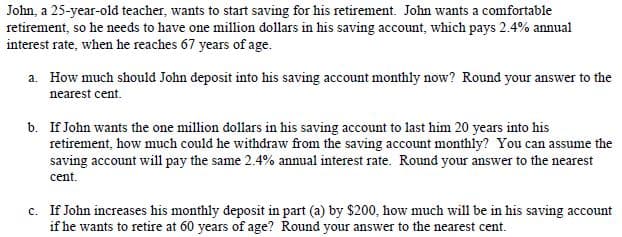How much should John deposit into his saving account monthly now? Round your answer te nearest cent. If John wants the one million dollars in his saving account to last him 20 years into his retirement, how much could he withdraw from the saving account monthly? You can assum saving account will pay the same 2.4% annual interest rate. Round your answer to the neares cent. TF John inor bin monthl: donecit o)br のう00 も
How much should John deposit into his saving account monthly now? Round your answer te nearest cent. If John wants the one million dollars in his saving account to last him 20 years into his retirement, how much could he withdraw from the saving account monthly? You can assum saving account will pay the same 2.4% annual interest rate. Round your answer to the neares cent. TF John inor bin monthl: donecit o)br のう00 も
Excel Applications for Accounting Principles
4th Edition
ISBN:9781111581565
Author:Gaylord N. Smith
Publisher:Gaylord N. Smith
Chapter27: Time Value Of Money (compound)
Section: Chapter Questions
Problem 6E
Related questions
Question
Please see Image

Transcribed Image Text:John, a 25-year-old teacher, wants to start saving for his retirement. John wants a comfortable
retirement, so he needs to have one million dollars in his saving account, which pays 2.4% annual
interest rate, when he reaches 67 years of age.
a. How much should John deposit into his saving account monthly now? Round your answer to the
nearest cent.
b. If John wants the one million dollars in his saving account to last him 20 years into his
retirement, how much could he withdraw from the saving account monthly? You can assume the
saving account will pay the same 2.4% annual interest rate. Round your answer to the nearest
cent.
c. If John increases his monthly deposit in part (a) by $200, how much will be in his saving account
if he wants to retire at 60 years of age? Round your answer to the nearest cent.
Expert Solution
Step 1
Period of investment =42 years
Retirement amount =$1000000
Annual interest =2.4%
Step 2
Future value FACTOR =(1+r)n-1/r
Future value FACTOR =(1.024)-42-1/0.024
Future value FACTOR =71.15
Future value =Future value FACTOR x annual payment
1000000=71.15 × annual payment
Annual payment =14054.81
Monthly payment =$1171.23
This amount should deposits in savings accounts monthly for retirement.
Step by step
Solved in 4 steps

Knowledge Booster
Learn more about
Need a deep-dive on the concept behind this application? Look no further. Learn more about this topic, accounting and related others by exploring similar questions and additional content below.Recommended textbooks for you

Excel Applications for Accounting Principles
Accounting
ISBN:
9781111581565
Author:
Gaylord N. Smith
Publisher:
Cengage Learning

EBK CONTEMPORARY FINANCIAL MANAGEMENT
Finance
ISBN:
9781337514835
Author:
MOYER
Publisher:
CENGAGE LEARNING - CONSIGNMENT

Pfin (with Mindtap, 1 Term Printed Access Card) (…
Finance
ISBN:
9780357033609
Author:
Randall Billingsley, Lawrence J. Gitman, Michael D. Joehnk
Publisher:
Cengage Learning

Excel Applications for Accounting Principles
Accounting
ISBN:
9781111581565
Author:
Gaylord N. Smith
Publisher:
Cengage Learning

EBK CONTEMPORARY FINANCIAL MANAGEMENT
Finance
ISBN:
9781337514835
Author:
MOYER
Publisher:
CENGAGE LEARNING - CONSIGNMENT

Pfin (with Mindtap, 1 Term Printed Access Card) (…
Finance
ISBN:
9780357033609
Author:
Randall Billingsley, Lawrence J. Gitman, Michael D. Joehnk
Publisher:
Cengage Learning

Intermediate Accounting: Reporting And Analysis
Accounting
ISBN:
9781337788281
Author:
James M. Wahlen, Jefferson P. Jones, Donald Pagach
Publisher:
Cengage Learning


Cornerstones of Cost Management (Cornerstones Ser…
Accounting
ISBN:
9781305970663
Author:
Don R. Hansen, Maryanne M. Mowen
Publisher:
Cengage Learning